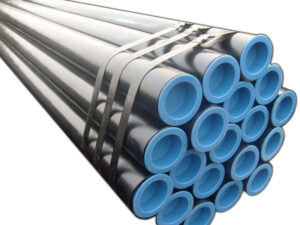A pipe is a tubular section or hollow cylinder, usually but not necessarily of circular cross-section, used mainly to convey substances which can flow — liquids and gases (fluids), slurries, powders, masses of small solids. It can also be used for structural applications; hollow pipe is far stiffer per unit weight than solid members.
In common usage the words pipe and tube are usually interchangeable, but in industry and engineering, the terms are uniquely defined. Depending on the applicable standard to which it is manufactured, pipe is generally specified by a nominal diameter with a constant outside diameter (OD) and a schedule that defines the thickness. Tube is most often specified by the OD and wall thickness, but may be specified by any two of OD, inside diameter (ID), and wall thickness. Pipe is generally manufactured to one of several international and national industrial standards. While similar standards exist for specific industry application tubing, tube is often made to custom sizes and a broader range of diameters and tolerances. Many industrial and government standards exist for the production of pipe and tubing. The term “tube” is also commonly applied to non-cylindrical sections, i.e., square or rectangular tubing. In general, “pipe” is the more common term in most of the world, whereas “tube” is more widely used in the United States.
Here are three processes for metallic pipe manufacture. Centrifugal casting of hot alloyed metal is one of the most prominent process. Ductile iron pipes are generally manufactured in such a fashion. Seamless (SMLS) pipe is formed by drawing a solid billet over a piercing rod to create the hollow shell. As the manufacturing process does not include any welding, seamless pipes are perceived to be stronger and more reliable. Historically seamless pipe was regarded as withstanding pressure better than other types, and was often more easily available than welded pipe.
Advances since the 1970s in materials, process control and non-destructive testing allow correctly specified welded pipe to replace seamless in many applications. Welded (also Electric Resistance Welded (“ERW”), and Electric Fusion Welded (“EFW”)) pipe is formed by rolling plate and welding the seam. The weld flash can be removed from the outside or inside surfaces using a scarfing blade. The weld zone can also be heat treated to make the seam less visible. Welded pipe often has tighter dimensional tolerances than seamless, and can be cheaper if manufactured in the same quantities.
ITOK TEJARAT ARMAN is a reputable source for all your industrial needs for pipes in different size and material.
- API Standards:
API 5L, API 5LS, API 5LX.
- ASME Standards:
ASME SA106 Grade B, ASME B31.1, ASME B31.3, ASME B36.10, ASME B36.19 - ASTM Standards:
ASTMA312, ASTM C76, ASTM D3033/3034, ASTM D2239, ASTM A53, ASTM A135, ASTM A106, ASTM A795, ASTM A72,ASTM A120, ASTM A134, ASTM A139, ASTM A155, ASTM A211, ASTM A312, ASTM A333, ASTM A333, ASTM A335, ASTM A358, ASTM A 369, ASTM A376, ASTM A381, ASTM A405, ASTM A419, ASTM A523, ASTM A524, ASTM A530 - ISO Standards:
ISO 14692, ISO 3183, ISO L245.

